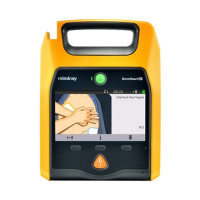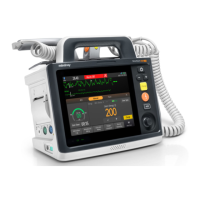5 - 10 Defibrillator/Monitor Operator’s Manual
• The alarm level for asystole, ventricular fibrillation, ventricular tachycardia, ventricular bradycardia,
extreme bradycardia, and extreme tachycardia alarms is always high and unchangeable. These
alarms are always on. As long as the alarm condition occurs, corresponding alarm will be triggered
whether arrhythmia analysis is switched on or off.
5.7.4 Changing Arrhythmia Threshold Settings
To change arrhythmia threshold settings:
1. Select the ECG parameter area to enter the [ECG Setup] menu.
2. Select [Arrhythmia >>] → [Arrh. Threshold >>].
In case an arrhythmia violates its threshold, an alarm will be triggered. The setting of [Asystole Delay] is relevant
to ARR relearning. When HR is less than 30 bpm, it is recommended to set [Asystole Delay] to 10 seconds.
You can also set arrhythmia threshold by selecting [ECG Setup] from the Configuration Main menu.
5.7.5 Initiating Arrhythmia Relearning Manually
Normally arrhythmia relearning allows the equipment to learn new ECG patterns to correct arrhythmia alarms
and heart rate value. We suggest you manually initiate arrhythmia relearning when you suspect the result of
arrhythmia analysis.
To initiate relearning manually:
1. Select the ECG parameter area to enter the [ECG Setup]menu
2. Select [Arrhythmia >>] → [Relearn Arrh.].
3. When the equipment is learning, the message “Learning ECG” is displayed in the technical alarm area.
• Arrhythmia relearning in the case of ventricular tachycardia may affect correct arrhythmia alarm.
Arrh. Event Range Default Step Unit
PVCs High 1 to 10 10 1 /
Asystole Delay 3 to 10 5 1 s
Tachy 60 to 300 Adult: 120
Pediatric: 160
5 bpm
Brady 15 to 120 Adult: 50
Pediatric: 75
5 bpm
Extreme Tachy 60 to 300 Adult: 160
Pediatric: 180
5 bpm
Extreme Brady 15 to 120 Adult: 35
Pediatric: 50
5 bpm
Multif. PVCs Window 3 to 31 15 1 Beats
V-Tach Rate 100 to 200 130 5 bpm
V-Tach PVCs 3 to 99 6 1 Beats
Pause Time 1.5, 2.0, 2.5 2.0 / s
Vbrd Rate 15 to 60 40 5 bpm
Vbrd PVCs 3 to 99 5 1 Beats

